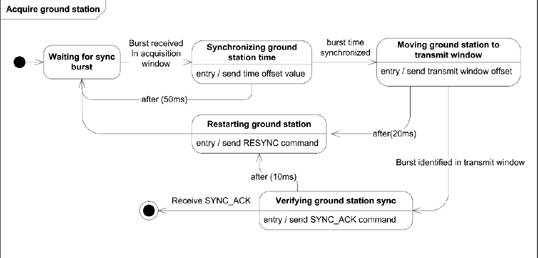Section 8.7. Variations on Statechart Diagrams
8.7. Variations on Statechart DiagramsIn addition to modeling behavior and protocols, statecharts have been used to capture real-time system behavior. As they do with many applications of UML diagrams, real-time system modelers frequently use tagged values and constraints to customize the syntax for their organization; however, almost all real-time diagrams include some notation to indicate time. A common notation is to use the keyword after to indicate a maximum allowable time for a transition to occur. Figure 8-19 shows a satellite uplink acquisition statechart that requires a ground station to respond to satellite commands within a fixed amount of time to prevent the acquisition sequence from failing and starting over. Since real-time systems are frequently involved in well-defined protocols, the line between real-time state machines and protocol state machines can blur. There is no real notational difference; it is a matter of what the modeler is trying to convey. Real-time state machines often model the internal states of a system, something Figure 8-19. A sample real-time statechart diagram deliberately avoided by protocol state machines. If the modeler doesn't capture the internal states of a system, or if the implementation is simple enough that there are no additional internal states, the state machine can wind up being a model of the protocol. Figure 8-19 is closer to a protocol state machine than a detailed implementation model; each state in the figure can be represented by one or more smaller, internal states in a real implementation. However, according to the strict definition of protocol state machines, entry activities can't be used, so Figure 8-19 isn't tagged with the {protocol} tag. |
EAN: 2147483647
Pages: 132